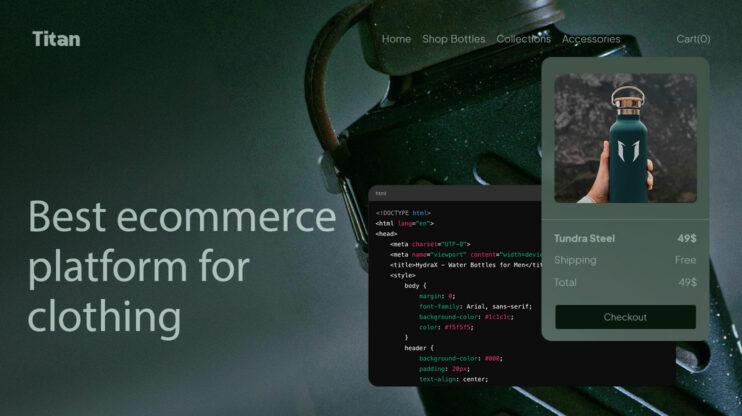The future of B2B ecommerce is changing quickly with new technology and changing buyer needs. As more businesses move online to make operations easier and meet the demand for smooth digital experiences, keeping up with the latest trends is essential to stay ahead of competitors.
In this article, we will discuss the top 10 B2B ecommerce trends changing digital commerce, highlighting opportunities for businesses to enhance efficiency, improve customer engagement, and drive growth. B2B ecommerce has great potential with AI, blockchain, and mobile tools. Businesses that adopt these trends can boost loyalty, sustainability, and efficiency. Before we dive deep into B2B ecommerce trends, let’s look into B2B ecommerce in more detail.
FAQ
What are the latest B2B ecommerce statistics?
How is AI impacting B2B ecommerce sales processes?
Which is the current trend in B2B ecommerce?
What is the future of B2B commerce?
What are the trends for B2B customer service?
What is B2B ecommerce?
B2Bt ecommerce refers to online transactions between businesses, where companies sell products or services to other businesses through digital platforms. Unlike B2C (business-to-consumer) ecommerce, B2B involves transactions between companies, which are often larger and more complex.
These platforms enable businesses to showcase their offerings while providing tools for pricing, ordering, payment processing, account management, and inventory tracking. The B2B ecommerce market is growing rapidly, valued at trillions of dollars globally, as more companies move sales online to meet changing buyer preferences. Today’s B2B buyers expect smooth, fast online experiences and self-service options, prompting sellers to enhance their digital presence.
A successful B2B ecommerce strategy includes a user-friendly, business-focused online store, strong customer service, and reliable support. As technology advances, companies must stay updated with emerging trends to remain competitive in this evolving digital marketplace.
10 B2B ecommerce trends you can use in 2025
B2B ecommerce is evolving as more businesses sell online, and buyers now expect user-friendly websites similar to consumer platforms. Companies are adopting trends like mobile-friendly designs, self-service, personalization, fast delivery, and AI tools to meet these demands. These changes make it easier for buyers to shop while helping sellers provide better service.
As online B2B sales grow, staying updated with these trends is essential. Businesses that adapt can gain a competitive edge, while those that don’t risk falling behind. Let’s look at 10 key B2B ecommerce trends for 2025 and how they can improve online sales and customer experiences.
Personalized shopping experiences
B2B buyers now want online stores to give them a custom experience. They expect websites to show products and content that fit their needs. This means B2B companies need to use data and technology in smart ways.
Many B2B sites now offer product recommendations based on past purchases. They also show different content to different types of customers. For example, a manufacturer might see different products than a retailer.
Personalization goes beyond just the website. B2B companies are using email, chat, and other tools to give a custom experience. They might send follow-up emails with products related to a recent purchase. Some B2B sites now let customers create their own product bundles. This gives buyers more control over their orders. It also helps companies sell more items together.
As AI gets better, personalization will become even more advanced. B2B sites might soon offer virtual assistants that learn each customer’s preferences. This could make online shopping faster and easier for busy business buyers.
AI-driven customer insights
AI is changing how B2B companies understand their customers. Here is how AI contributes to B2B ecommerce:
- Provides enhanced customer insights: AI analyzes data (past purchases, browsing history, and trends) to predict customer needs and offer personalized product recommendations.
- Improves product development: AI tracks product usage post-sale, providing insights for improvements and new features.
- Efficient customer support: AI-powered chatbots handle routine inquiries, allowing sales teams to focus on complex tasks.
- Personalized experiences: Tailored marketing and product offers foster stronger business relationships.

Thus, AI is making it easier for B2B companies to give each customer a personalized experience. This helps build stronger, longer-lasting business relationships.
Sustainability initiatives
Many B2B companies are going green in 2024. They want to cut waste and help the planet. This shift comes from customer demand and new rules. Some firms now use eco-friendly packaging. They pick materials that break down easily or can be reused. Others focus on making their supply chains greener. They work with suppliers who care about the environment too.
Energy use is another big area. More businesses are switching to renewable power sources. They’re putting solar panels on warehouses or buying wind energy. Companies are also looking at their products. They’re designing items that last longer or can be fixed. This helps cut down on waste. Some are even taking back old products to recycle them.
These green moves aren’t just good for Earth. They can save money and attract customers who care about the environment. In the future, we’ll likely see even more B2B firms care about sustainability.
Advanced payment solutions
B2B ecommerce is changing how companies pay each other. More businesses now use digital wallets and automated billing systems. These new tools make paying faster and easier. Companies are moving away from paper checks. They prefer electronic methods like real-time payments and virtual credit cards. These digital options can save time and money.
Security is a big focus for B2B payments. New systems use better encryption to protect sensitive data. They also have smart fraud detection to spot issues quickly. Businesses want flexible payment choices. Some buyers like to spread out large purchases over time. Others want instant payment options for urgent orders.
Mobile payments are growing in B2B too. More executives use smartphones to approve transactions on the go. This helps speed up deals and improves cash flow.
Omnichannel integration
B2B companies are adopting omnichannel strategies to meet customer expectations, combining online and offline channels for a seamless buying experience. Buyers expect multiple touchpoints, so firms are linking websites, mobile apps, and in-person sales teams. This allows customers to start purchases on one platform and complete them on another while enabling sales reps to access unified customer data.
Self-service tools like online catalogs, pricing, and reorder features empower buyers, enhancing convenience. Data sharing across channels is critical for success, prompting companies to invest in systems that unify customer information. Additionally, with B2B buyers increasingly using smartphones for work, businesses are optimizing their sites and apps for mobile use.
Mobile commerce optimization
More B2B buyers use smartphones to research and purchase products. Companies need to make their websites work well on mobile devices. This means creating simple designs that load quickly on phones. Businesses should use large buttons and text that’s easy to read on small screens. They should also let customers pay with mobile wallets like Apple Pay.
Mobile apps can make buying even easier for repeat customers. Apps store login info and payment details for faster checkout. They can also send push notifications about sales or restocked items.
Voice commerce adoption
More B2B companies are adding voice search and ordering to their ecommerce sites. This trend lets buyers use spoken commands to find products and place orders hands-free. Voice tools can speed up the buying process for busy professionals. Some B2B sellers now offer voice-activated reordering for repeat purchases. Buyers can simply ask to replenish supplies without typing anything. This saves time for common orders.
Voice commerce also helps with product searches. Buyers can ask questions about items and get quick answers. This makes it easier to compare options and find the right products. Mobile apps are a key part of B2B voice commerce. Many professionals use voice commands on their phones while multitasking. This fits well with the on-the-go nature of B2B buying.
As voice tech improves, we’ll likely see more B2B companies add these features. The goal is to make buying faster and more convenient for business customers.
Blockchain for supply chain
Blockchain technology is changing B2B ecommerce supply chains. It creates a secure digital record of transactions that can’t be changed. This helps companies track products from start to finish. With blockchain, businesses can see where items come from and how they move. This makes the supply chain more open and easy to understand. It also helps stop fake products and theft.
Blockchain can speed up payments between businesses. It allows for smart contracts that trigger payments automatically when certain conditions are met. This can improve cash flow for suppliers. The technology also helps with recalls. If there’s a problem with a product, companies can quickly find where it came from and which other items might be affected.
With many businesses using blockchain, it could become a standard part of B2B ecommerce supply chains. This may lead to smoother operations and better trust between trading partners.
Augmented Reality (AR) shopping
Augmented reality (AR) is changing how B2B companies sell products online. This technology lets buyers see items in 3D before buying them. AR works on phones, tablets, and computers. With AR, businesses can show big products like machines or furniture. Buyers can see how these things fit in their space. They can also look at small parts up close.
AR helps cut down on returns. When buyers can see products clearly, they make better choices. This saves time and money for both sides. Some B2B companies use AR for training. They show workers how to use new tools or fix problems. This makes learning faster and safer.
AR shopping is still new in B2B. But it’s growing fast. More companies will likely use it in the coming years. As the tech gets better, so will the ways businesses use it to sell.
Subscription-based models
B2B companies are turning to subscription models to boost customer loyalty and create steady income streams. This trend is gaining ground as more businesses seek predictable revenue. Subscription services in B2B come in many forms. Some offer regular product shipments, while others provide ongoing access to software or services. These models help companies build stronger ties with their clients.
For buyers, subscriptions can mean cost savings and easier budgeting. They often get better deals through long-term commitments. Sellers benefit from more stable cash flow and chances to upsell. Many B2B firms now offer tiered subscription plans. These let customers choose the level of service that fits their needs. As needs change, businesses can upgrade or downgrade easily.
Data shows that subscription-based B2B services are likely to keep growing. Companies that adopt this model may gain an edge over those sticking to traditional sales methods.
Conclusion
The future of B2B ecommerce lies in adaptability and innovation. As digital transformation accelerates, businesses must stay informed about B2B ecommerce trends like personalization, AI-driven insights, sustainability, and omnichannel integration to remain competitive.
In this article, we discussed the most popular B2B ecommerce trends. Companies that proactively adopt these trends will position themselves for sustained growth, improved customer loyalty, and greater market relevance in the dynamic world of digital commerce. The key to success is staying agile and leveraging these advancements to meet and exceed the demands of the future.














